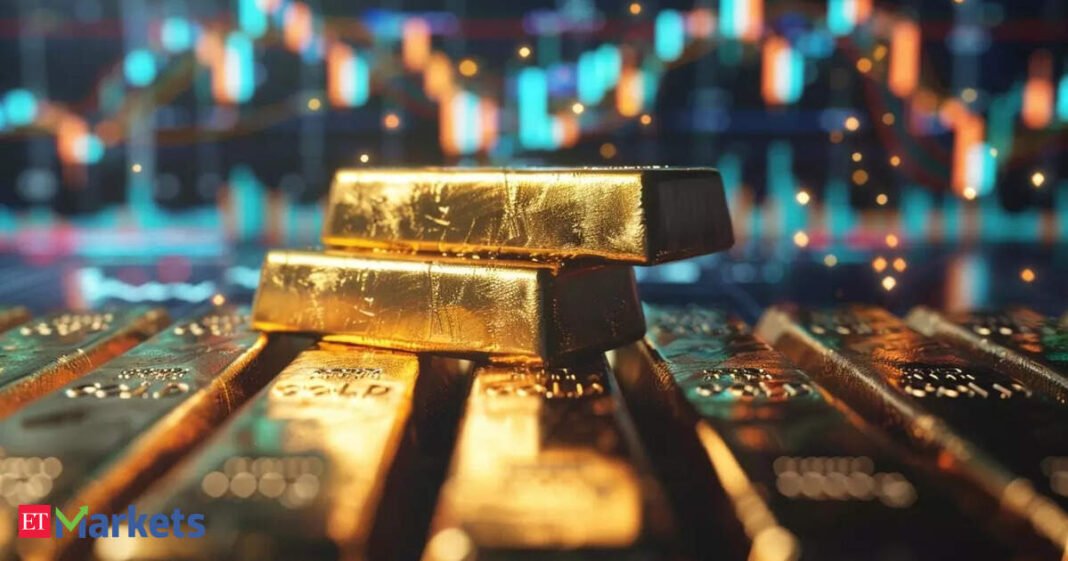Contents
Gold Prices May Be Nearing Peak as Economists Predict Downside Risks
Gold, which has surged over 40% in the past year, may be close to its peak, according to economists and researchers, who point to immediate downside risks for the safe-haven asset that has benefited from unsettled geopolitics and central bank buying. Citi, Motilal Oswal, and Fitch Ratings’ research unit, BMI, predict an end to the gold rally as global macroeconomic conditions change, potentially pushing gold prices down.
The gold market has been on a rollercoaster ride over the past year, with prices surging over 40% in dollar terms. However, economists and researchers are now predicting that the yellow metal may be nearing its peak, with downside risks emerging. According to Citi, Motilal Oswal, and Fitch Ratings’ research unit, BMI, the gold rally may be coming to an end, driven by weaker investment demand, improving global growth prospects, and rate cuts by the Federal Reserve. The predictions come as gold prices have risen 86% to $3,342 since January 2022, driven by the Ukraine-Russia war, troubles in the Middle East, and persistent central bank purchases.
Factors Contributing to the Predicted Downside
Several factors are contributing to the predicted downside risks for gold. These include:
* Weaker investment demand: As global growth prospects improve, investors may become less risk-averse and less likely to invest in safe-haven assets like gold.
* Improving global growth prospects: As the global economy recovers, the need for safe-haven assets like gold may decrease.
* Rate cuts by the Federal Reserve: Lower interest rates may reduce the appeal of gold, as investors may seek higher-yielding assets.
* Inflation: Rising inflation may reduce the purchasing power of gold, making it less attractive to investors.
* US dollar strength: A strong US dollar may make gold more expensive for investors, reducing demand.
Predictions from Economists and Researchers
Citi predicts that gold prices may return to $2500 to $2700 an ounce by the second half of 2026, while Motilal Oswal says that annual gains beyond 32% are rare. The Fitch unit, BMI, says that downside pressures are building up, pushing gold prices down, although a return to pre-Covid price levels is unlikely. “Despite our outlook for gold prices to weaken, we do not see a return to pre-Covid levels,” said the Fitch unit. “Gold prices will average USD2,720/oz during 2025-2029, compared with USD1,393/oz in 2019.”
Impact on Investors
The predicted downside risks for gold may have significant implications for investors. According to ICICI Bank, gold prices could be between $3300 and $3500 per ounce by December, driven by a potential backloaded easing cycle by the Federal Reserve. However, if the Federal Reserve abstains from cutting rates, a sharp rise in the US dollar and bond yields could lower gold’s appeal, bringing prices back to $2500/oz. Investors are expected to seek further refuge in the asset if significant escalation is seen in any of the ongoing conflicts.
Historical Data and Market Fatigue
Historical data suggests that annual gains beyond 32% are rare, reinforcing the case for caution at current levels. Motilal Oswal said in a report that gold prices would consolidate or could move sideways, with signs of market fatigue. Factors to watch in the near-term are the Federal rate cuts, inflation, and the US dollar strength. Rate cuts may lower bond yields, shifting investments toward non-yielding yet safe-haven assets like gold, according to BMI.
Conclusion:
In conclusion, the gold market may be nearing its peak, with downside risks emerging. Economists and researchers are predicting an end to the gold rally, driven by weaker investment demand, improving global growth prospects, and rate cuts by the Federal Reserve. Investors should exercise caution and consider the potential implications of the predicted downside risks for gold. As the global economy continues to evolve, it is essential to stay informed and adapt to changing market conditions.
Keywords: gold prices, safe-haven asset, geopolitics, central bank buying, Citi, Motilal Oswal, Fitch Ratings, BMI, Federal Reserve, interest rates, inflation, US dollar strength, investors, market fatigue, historical data.
Hashtags: #goldprices #safehavenasset #geopolitics #centralbankbuying #Citi #MotilalOswal #FitchRatings #BMI #FederalReserve #interestrates #inflation #USdollarstrength #investors #marketfatigue #historicaldata
Source link




